
We have been monitoring data collection efforts for an experiential program that has spanned the course of about six months. This program is activating across more than a dozen different markets.
At this time of publication, we have received fewer than 300 consumer exit surveys and are trending short of our target count of 350. So… what’s going on with data collection?
DATA COLLECTION IN EVENT MARKETING
Data collection is one of the biggest challenges we face in experiential measurement. Often, we rely on Brand Ambassadors or other field staff to collect the data we need to determine the success of the program. Typically, we use two data sources to measure success:
• Consumer surveys,
• Field staff recap metrics (FSR).
FSR’s are mandatory, and therefore receiving them is usually not an issue. However, consumer surveys are not mandatory and can be seen as a low priority in comparison to the dozen other things that field staff are responsible for. (Field staff is also responsible for in-market staff training, set-up, sample distribution, etc.).
DATA COLLECTION METHOD
Is there a way to guarantee we meet our goal every time? We cannot control everything that may factor into data collection efforts. However, we do have a method for maximizing results in the field. Our method consists of the following:
- Field Staff Training – As part of our service, we offer Field Staff Training, in person or via phone. We work with the account manager to develop training materials. Often times we participate in the training to help field questions about data collection or alleviate concerns about what is expected.
- PortMA’s iOS App – We have a pretty slick field staff data collection app that works on any smart device running iOS.
- Data Collection Updates – We regularly update client teams on how data collection is faring on a weekly or bi-weekly basis. This allows us to catch and address small issues before they become big ones. (Examples include activating in low traffic areas, compliance challenges, etc.).
In the case of this event marketing program, the client team has been kept in the loop throughout our data collection efforts. As the program draws to a close, we will be meeting with them to confirm dates of fieldwork. We will also discuss the reporting strategy, which will most likely be top line. While having less than 300 completed surveys limits our analytical prowess, it does not prevent us from providing a report on overall findings and trends to watch out for next year.

Additional Resources
FOR EXPERIENTIAL MARKETERS
- Experiential Measurement Blueprint
- Event Impression Calculator
- Experiential ROI Benchmarking Reports
- Event Measurement Video Tutorials
Additional Reading
- How to Build an Experiential Marketing Data Stack that Improves ROI
- How Real-Time Event Feedback Boosts Engagement and ROI
- How to Use MMM Frameworks to Measure Experiential Campaigns and Marketing ROI
- How Demonstrating Value Strengthens Client Relationships in Experiential Marketing
- How the RIV Paradigm Approach to Reach and Impact Drive Marketing ROI
